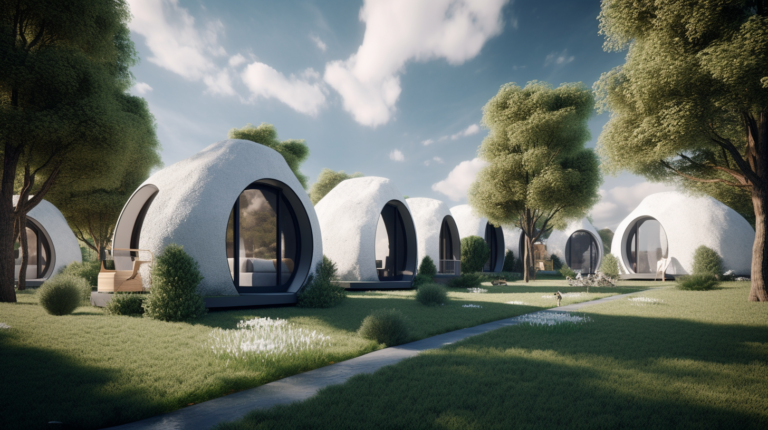As housing costs continue to rise, and the demand for sustainable, affordable living solutions grows, tiny homes are rapidly emerging as a game-changing option. For millennials, retirees, and anyone looking to simplify their life, tiny homes provide a perfect solution—affordable, eco-friendly, and customizable. But what’s driving this trend into the future is 3D printing technology, which is revolutionizing the construction process. And for investors, this convergence of tiny homes and 3D printing presents an incredible early-stage opportunity. With the 3D printing construction market projected to grow exponentially, now is the time to consider getting in on the ground floor.
Why 3D Printing is the Future of Tiny Homes: Affordable, Sustainable, and Fully Customizable
The synergy between 3D printing and tiny homes is paving the way for a new era in affordable housing. Here’s why 3D printing is the perfect fit for the tiny home market:
- Speed: The shell of a 3D-printed home can be completed in just 48-72 hours, compared to up to several weeks using traditional construction methods.
- Cost Efficiency: 3D printing can reduce construction costs , making tiny homes even more affordable and accessible to more people.
- Sustainability: 3D printing minimizes waste to less than 10%, drastically reducing the environmental impact compared to traditional methods, which often create over 30% waste.
- Customization: 3D printing offers endless design possibilities, allowing for highly personalized homes that are unique and adaptable to individual needs.
- Resiliency: 3D printed homes can be made to withstand natural disasters, with superior wind, fire, water and termite resistance, compared to traditional stick homes or prefab modules.
As 3D printing continues to evolve, it enhances the affordability, sustainability, and flexibility of tiny homes, making them even more appealing to a wider audience. With the demand for affordable housing growing worldwide, the potential for 3D-printed tiny homes is enormous.
Real-World Success: The Wolf Ranch Project
One of the most exciting examples of this 3D-printed tiny home revolution is the Wolf Ranch project in Georgetown, Texas. Developed by ICON and designed by the renowned Bjarke Ingels Group (BIG), the project will build 100 homes using cutting-edge 3D printing technology. As of 2023, over 80 homes are already under construction, demonstrating that this isn’t just an idea—it’s a rapidly growing reality.
The success of projects like Wolf Ranch is proving that 3D printing can scale to meet the global demand for affordable housing, making it a prime opportunity for investment.
Why Now is the Time to Invest
As the 3D printing revolution continues to reshape the construction industry, the market for 3D-printed tiny homes is rapidly gaining traction. With the 3D printing industry projected to grow to a staggering $296 billion by 2031, the tiny home movement, combined with 3D printing’s cost-saving, sustainable, and fast-building capabilities, positions this sector for significant expansion and continued growth in the coming years.
For investors, this is a rare opportunity to get in early on a transformative technology that is set to revolutionize the housing market. Crowdfunding platforms like StartEngine and Wefunder are offering retail investors access to cutting-edge companies,which are leading the way in 3D-printed construction. This early-stage opportunity means you can be part of a rapidly growing market before it reaches its full potential.
Which Current Investment Opportunity Stands Out
Among the front-runners in the 3D-printed construction space is Printera, a company that is making waves with its innovative Pre-Printed™ concrete elements. These high-quality concrete components are produced in a controlled environment, drastically reducing waste, improving build quality, and cutting costs.
Printera’s Key Achievements:
- Florida’s First 3D-Printed House
- Florida’s First 3D-Printed Concrete Reef
- New York City’s First 3D-Printed Concrete Project
Printera is also making strides in sustainability by using carbon-sequestering materials like CaptureCrete, which absorb up to 10% of their weight in CO2. With these early achievements the company is positioning itself as a key player in the 3D-printed space.
If you’re curious about Printera’s potential and want to learn more, check out their landing page for additional details and opportunities.
Looking Ahead: A New Era in Housing and Investment
The 3D-printed tiny home market is on the verge of explosive growth. With technology advancing rapidly and the demand for affordable, sustainable housing rising, this is an exciting time for investors looking to enter a transformative industry. The combination of 3D printing’s speed, cost-efficiency, and customization is reshaping how we think about homes—and how they’re built.
As this market continues to expand, opportunities are emerging for those who want to get involved early. The future of affordable, eco-friendly living is being built right now, and companies like Printera are leading the charge. For investors, this is your chance to be part of the next big shift in housing.

